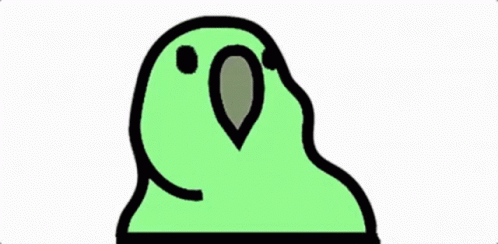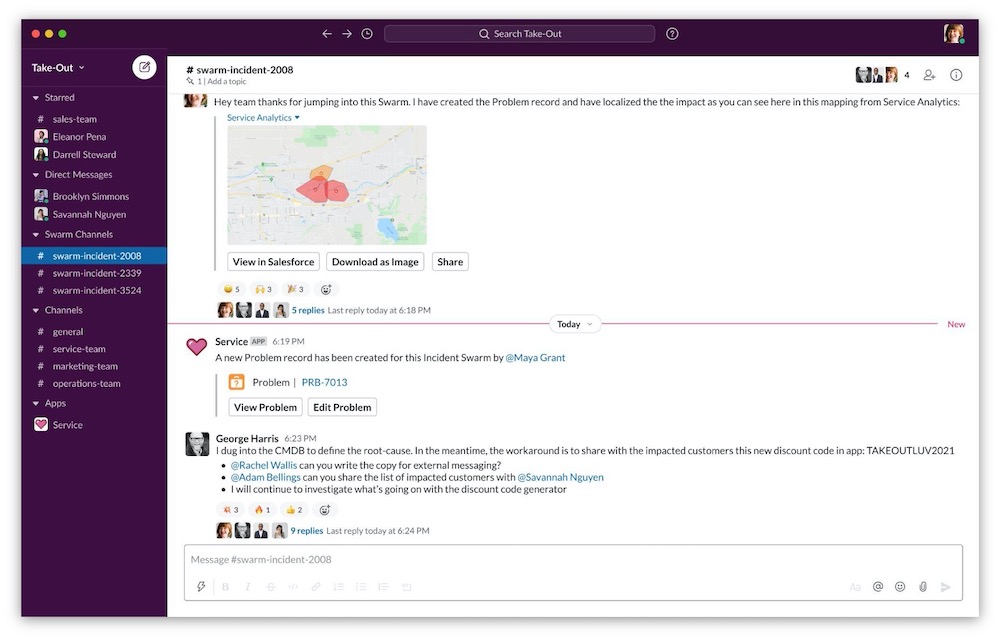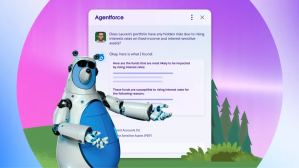What’s the most time you’ve spent on hold with customer service? How frustrated were you? Imagine a world where that wait time is non-existent. That’s just part of the potential future with Slack as your Digital HQ for Service.
Clara Shih, the CEO of Service Cloud, explains some of the wide-ranging benefits of bringing Service Cloud into Slack, from reducing wait times, finding experts faster, to even party parrot emojis.
Q. Starting with the most important question, what’s your favorite emoji or gif?
I love the Service Cloud heart and of course, party parrot. I learned something recently which blew my mind — you can build workflows that are kicked off by specific emojis. For example, a service agent could use the hand-raise or the eyes emoji to kick off a workflow that shows she is working on a case so others know they don’t have to attend to it. It’s powerful to think about emojis not just as expressive, but action-oriented.


Q. When you first heard about Salesforce and Slack teaming up, what went through your mind?
Tremendous excitement. A major issue in customer service today is addressing problems that are too complicated for a bot or frontline service agent to resolve on their own. When these complex issues get handed off to other teams and departments, balls can drop. Communication silos and botched handoffs are usually what drive bad customer experiences. Slack addresses this problem of balls dropping across departments because it connects the entire company in service of the customer.
“Slack addresses this problem of balls dropping across departments because it connects the entire company in service of the customer.”
Clara shih, CEO, Service CLoud
Instead of the customer support team having to send an email to another department and never hearing back, they can problem-solve in real time, with everyone connected on the same Slack channel. In the event you need to connect with external partners, such as a reseller or shipping company, Slack Connect allows companies to do so safely, securely, and instantly. When work flows, trust and transparency grow both within companies, and between companies and their customers and partners.
Q. You’ve talked in the past about the importance of asynchronous communication and permanent messaging. What does that mean and why is that so important for businesses in today’s world?
Asynchronous, permanent messaging are simple, yet powerful concepts for how we relate to each other.
“Asynchronous” just means that the conversation doesn’t have to happen in real time. That’s part of the beauty of Slack. I can message you, and if you’re in another time zone and currently asleep, or you’re working from home and you have to focus on taking care of your children for the next couple of hours, you can come back to the message when you’re available and get back to me. This is the reality that most workers at home right now have to live with. It’s really important because it liberates us in terms of when we can work. We can be much more flexible for different types of people and work with broader sets of people around the world.
“‘Permanent’ messaging is important for historical knowledge and context. As organizations get bigger, you end up having a lot of the same FAQs and conversations across different pockets of people because they’re unaware that someone else in the company has already had that conversation and figured out the answer.”
Clara Shih, CEO, Service Cloud
“Permanent” messaging is important for historical knowledge and context. As organizations get bigger, you end up having a lot of the same FAQs and conversations across different pockets of people because they’re unaware that someone else in the company has already had that conversation and figured out the answer. The power of Slack is that all of those conversations persist and are searchable. You end up creating this evolving knowledge store that makes the entire “hive mind” smarter and better over time. These two concepts, asynchronous communication and searchable permanent messaging, are game changers for any organization for driving connectedness, intelligence, and continuous improvement.

Q. A recent study found Slack integrations in Service Cloud lead to an 11% improvement in customer satisfaction scores. What are the specific advantages of integrating Slack and Service Cloud that actually lead to better customer experiences? What is swarming?
When an agent comes across an issue she can’t solve on her own, she’s empowered to initiate what we call a “swarm” in Slack, finding the right subject matter experts who can address the issue. Say an e-commerce site just went down and customers can’t log in. The agent can’t fix this on her own, so she can spin up a Service Cloud swarm in Slack with the DevOps and engineering teams to get the site back up as quickly as possible.
“When an agent comes across an issue she can’t solve on her own, she’s empowered to initiate what we call a ‘swarm’ in Slack, finding the right subject matter experts who can address the issue.”
CLara Shih, CEO, Service CLoud
As these back-office operations teams work on a fix, they can keep her and the rest of the contact center, providing transparency that they’re actively working on the issue. For example, sharing that “We estimate the backup will be an hour and will provide you with status updates every 15 minutes.” That transparency through Slack can even be proactively extended to customers. The company can proactively notify all affected customers about the site outage before those customers pick up the phone to call the contact center.
Q. How will the Digital HQ for Service help service agents, especially new employees, find answers faster?
One of the most powerful things that Service Cloud and Slack can do together is surface relevant content and prior conversations to service agents. Customers often have the same questions. Whether you’re a new or veteran agent, rather than interrupt teams with questions that have already been discussed, point them to the evolving knowledge base already in Slack — all the nuances, decisions, thinking behind the decision, and the final answer. That gives agents the right solutions faster without repeatedly asking domain experts the same questions.
Especially in emerging knowledge areas, such as product recalls or developing weather events like natural disasters, you don’t want to waste the time of people on the ground. It’s best to just expose all the problem solving they’ve already done in Slack.”
clara shih, ceo, service cloud
Especially in emerging knowledge areas, such as product recalls or developing weather events, like natural disasters, you don’t want to waste the time of the people on the ground. It’s best to just expose all the problem solving that they’ve already done in Slack, where messages are persistent, searchable, and proactively surfaced to service agents.
Q. How do you envision automation and AI improving Service Cloud in the future?
There are three pillars in our Service Cloud Einstein AI approach: automation, assistance, and optimization. For automation, Service Cloud has a point-and-click interface for companies to create self-service solutions for common requests, so bots and portals can deliver customers faster resolutions. That frees human agents for higher-order problem-solving and situations requiring high-empathy conversations. Some examples include customers wanting to update their mailing address or reset their account password — generally not instances customers want to have to call in for.
The Service Einstein assistance pillar empowers service agents to do their best work, providing timely, action suggestions. Einstein learns what the best agents do and uses those behaviors as the gold standard to guide everyone else, like understanding how much time an agent should talk versus the customer talking; or an insurance agent’s tone when talking to a customer who just experienced an emergency.
Finally, the Service Einstein optimization pillar focuses on mining workflows and conversations to find opportunities for improvement, such as identifying situations that should be automated and where service agents might need further training or assistance.
Einstein learns what the best agents do and uses those behaviors as the gold standard to guide everyone else, like understanding how much time an agent should talk versus the customer talking; or an insurance agent’s tone when talking to a customer who just experienced an emergency.”
clara shih, ceo, service cloud
All the pillars work symbiotically. Say your contact center is getting flooded with calls, causing customers to be placed on hold for over an hour to talk to an agent. Clearly not a great customer experience. Our new Einstein Conversation Mining in Service Cloud mines these call transcripts to understand why people are calling. Our analysis can reveal the top reasons people are calling on a quarterly and monthly basis, identify opportunities for self-service via bots and portals, deflect these types of calls going forward, provide volume relief for the contact center and improve experiences for customers calling in with more complex requests requiring an agent conversation. Over time, the entire organization continuously improves, responds with agility to real-time changes, and delivers a better service experience while making better use of their workforce.
Q. How will Slack within Salesforce affect team culture?
76% of workers saying how a company collaborates is a direct reflection of work culture, so I think Slack will have a profound impact on culture. Using Slack at Salesforce has already transformed our team’s connectedness, responsiveness, and speed, and replaced unnecessary meetings and emails.
This cultural impact has never been more important than now, when many of us are stuck at home indefinitely. As my former Stanford professor Bob Sutton likes to say, “Culture is a ground war, not an air war.” This means culture isn’t created by cultural edicts or company values that are shared with new hires as part of their onboarding. Culture is what happens day-to-day on the ground, every interaction. Right now with so many people working from home and not being able to interact or build social capital and relationships by walking the halls of the office, Slack as a Digital HQ provides a digital substitute for those one-to-one, one-to-few, or one-to-many interactions. The expressiveness of gifs, emojis while sometimes fun on the surface, that’s what creates levity, and we all need that in the workplace.
Culture is what happens day-to-day, on the ground, every interaction… the expressiveness of gifs, emojis, while sometimes fun on the surface, that’s what creates levity, and we all need that in the workplace.”
clara shih, ceo, service cloud
For more innovations and features in the latest Service Cloud, click here.
One-on-one with Marketing Cloud’s EVP on the benefits of using Slack as your Digital HQ for Marketing here
How AI and Einstein will supercharge productivity, according to Salesforce’s SVP of Product Management for Slack.



















